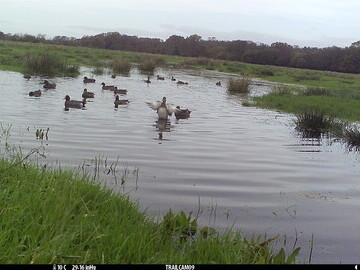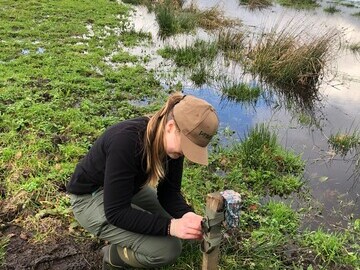A new place in the country for Ratty, and friends
“These habitat improvements are already benefitting a range of other water meadow species, including invertebrates and threatened waders
Water vole reintroduction on farmland boosting other wildlife
A recent reintroduction of a threatened native species to the Lower Avon Valley on the Hampshire – Dorset border has provided a welcome boost to other species too, say scientists from New Forest-based national conservation charity the GWCT.
Immortalised by Kenneth Grahame as poetic dreamer Ratty in The Wind in the Willows, the native water vole (Arvicola amphibius) is a rare sight in the British countryside today. Habitat loss and predation have diminished the population of Britain’s largest vole by over 90% and they are believed to be extinct in 97% of their former range.
This summer, 60 water voles were released into the water meadows of the River Avon on the Bisterne Estate south of Ringwood to try to re-establish a viable population. Ahead of the release, the estate’s gamekeeper Rupert Brewer and wetlands ecologist Lizzie Grayshon from the GWCT worked hard to create the perfect home for the new residents. Now, trail cameras are showing that the improved habitats are also attracting winter visitors who have not been seen there in numbers for many years.
“We are seeing far more waterfowl using the river meadows,” said Lizzie. “Our trail cameras are showing good numbers of less common species such as gadwall and widgeon. It is really encouraging to see them as it shows that our habitat work is paying off for a wide range of species.
“The water vole reintroduction, and the benefits for other threatened wildlife, shows that not all species reintroductions require re-wilding of the landscape or designation as nature reserves,” continued Lizzie. “Wildlife can thrive on farmland when there is active management of habitat and predation, driven by a landowner or manager committed to conservation.”
When a group of water voles was looking for a new home after being displaced as a result of the Salisbury River Park flood defence scheme, the GWCT’s head of predation research Dr Mike Short suggested the Bisterne Estate. Mike and Lizzie have worked extensively with the estate through the charity’s Waders for Real project, which successfully reversed the decline of red-listed breeding waders such as lapwing by working with farmers in the Avon Valley. Lizzie is also facilitator for the Avon Valley Farmer Cluster – a group of farmers working together to boost biodiversity on productive farmland.
Rupert Brewer’s remarkable conservation work and carefully targeted predation management has made Bisterne a haven for wildlife. Sadly though, water voles were all but extinct on this part of the Avon, largely as a result of predation by the introduced North American Mink (Neovison vison). The notorious release of thousands of American mink from a fur farm near Ringwood in the 1990s increased an existing population in the valley. In wetlands, mink predation alone can retard water vole populations by up to 60%.
To prepare for the water voles’ arrival, willow and debris was cleared from 3,440 metres of the herringbone system of drainage ditches, aiding waterflow and encouraging wetland plants such as reeds, rushes and sedges to thrive and provide the new water vole population with vital food and shelter. Carefully timed grazing by cattle will keep the vegetation low enough to suit the water voles and the waders.
“The really good news,” said Lizzie, “is that these improvements are already benefitting a whole range of other water meadow species in the Avon Valley, including invertebrates and threatened wading birds”.
“The ducks don’t like to use areas where vegetation hangs over the water, preventing them from seeing predators coming, so the areas we cleared for the benefit of the water voles and the waders are also suiting them.”
Under Rupert Brewer’s watchful eye, and as one of the ‘priority species’ chosen by the members of the Avon Valley Farmer Cluster, the future looks bright for the Avon Valley’s newest residents, and many of their friends.
Why the relocation?
Although the Salisbury River Park flood defence and regeneration scheme will bring habitat improvements in the longer term, as a protected species under the Wildlife and Countryside Act, the water vole population needed to be removed from harm’s way and relocated under a special licence. Funding from the scheme allowed Lizzie and Rupert to carry out habitat improvements at Bisterne before the water voles took up residence.
At just twelve individuals, the population was too small to be viable so a further 48 water voles were captive bred for release at Bisterne. The success of the reintroduction will be assessed when specialist conservationists from the Derek Gow Consultancy, who released the water voles, return to the meadows to release another 50 next year.
Watch the water vole release youtube.com/watch?v=kP_FxGYeTls
Or read more gwct.org.uk/blogs/news/2022/october/water-voles-a-new-place-in-the-country-for-ratty/
Ends
Note to editors
The Game & Wildlife Conservation Trust (GWCT) gwct.org.uk – providing research-led conservation for a thriving countryside. The GWCT is an independent wildlife conservation charity which has carried out scientific research into Britain’s game and wildlife since the 1930s. We advise farmers and landowners on improving wildlife habitats. We employ 22 post-doctoral scientists and 50 other research staff with expertise in areas such as birds, insects, mammals, farming, fish and statistics. We undertake our own research as well as projects funded by contract and grant-aid from Government and private bodies.
Farmer Clusters: farmerclusters.com - The Avon Valley Farmer Cluster is one of more than 200 farmer clusters across the UK. Farmers and land managers do a lot for Britain’s rural environment, but there is only so much that an individual, acting in isolation, can achieve on their own. By working together, helped by an advisor or ‘facilitator’, farmers and land managers can collectively deliver greater benefits for soil, water and wildlife at a landscape scale. The Game and Wildlife Conservation Trust (GWCT) helped develop the concept.
Salisbury River Park www.salisburyriverparkphase1.com
The Salisbury River Park is a £27 million transformational scheme to reduce flood risk to over 350 homes and businesses in Salisbury. It will also create 2 hectares of enhanced riverside habitat for the benefit of wildlife, remove obstructions to allow fish migration to continue upstream and create 13 hectares of high quality public open space. Another benefit will be enhanced foot and cycle paths that benefit residents and visitors. Construction began in July 2022 and it is expected main construction works will be completed in spring 2024.
Press release distributed by Pressat on behalf of Game & Wildlife Conservation Trust, on Monday 28 November, 2022. For more information subscribe and follow https://pressat.co.uk/
Conservation Birds Wildlife Farming Farmer Cluster Hampshire Dorset GWCT Water Voles Reintroductions Ringwood Christchurch Charities & non-profits Environment & Nature Farming & Animals Leisure & Hobbies
You just read:
A new place in the country for Ratty, and friends
News from this source:



